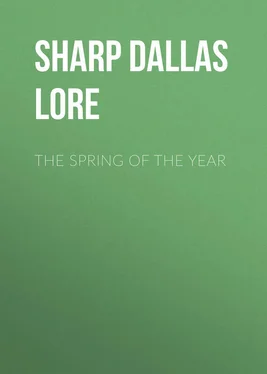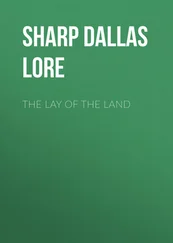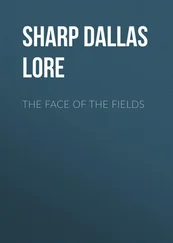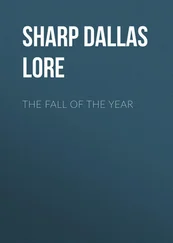Dallas Sharp - The Spring of the Year
Здесь есть возможность читать онлайн «Dallas Sharp - The Spring of the Year» — ознакомительный отрывок электронной книги совершенно бесплатно, а после прочтения отрывка купить полную версию. В некоторых случаях можно слушать аудио, скачать через торрент в формате fb2 и присутствует краткое содержание. Жанр: Природа и животные, foreign_antique, foreign_prose, на английском языке. Описание произведения, (предисловие) а так же отзывы посетителей доступны на портале библиотеки ЛибКат.
- Название:The Spring of the Year
- Автор:
- Жанр:
- Год:неизвестен
- ISBN:нет данных
- Рейтинг книги:4 / 5. Голосов: 1
-
Избранное:Добавить в избранное
- Отзывы:
-
Ваша оценка:
- 80
- 1
- 2
- 3
- 4
- 5
The Spring of the Year: краткое содержание, описание и аннотация
Предлагаем к чтению аннотацию, описание, краткое содержание или предисловие (зависит от того, что написал сам автор книги «The Spring of the Year»). Если вы не нашли необходимую информацию о книге — напишите в комментариях, мы постараемся отыскать её.
The Spring of the Year — читать онлайн ознакомительный отрывок
Ниже представлен текст книги, разбитый по страницам. Система сохранения места последней прочитанной страницы, позволяет с удобством читать онлайн бесплатно книгу «The Spring of the Year», без необходимости каждый раз заново искать на чём Вы остановились. Поставьте закладку, и сможете в любой момент перейти на страницу, на которой закончили чтение.
Интервал:
Закладка:
Dallas Lore Sharp
The Spring of the Year
INTRODUCTION
Ithas been my aim in the thirty-nine chapters of the three books in this series to carry my readers through the weeks of all the school year, not however as with a calendar, for that would be more or less wooden and artificial; but by readings, rather, that catch in a large way the spirit of the particular season, that give something definite and specific in the way of suggestions for tramps afield with things to look for and hear and do. Naturally many of the birds and animals and flowers mentioned, as well as woods and aspects of sky and field, are those of my own local environment – of my New England surrounding – and so must differ in some details from those surrounding you in your far Southern home or you on your distant Pacific coast, or you in your rich and varied valley of the Mississippi, or you on your wide and generous prairie. But the similarities and correspondences, the things and conditions we have in common, are more than our differences. Our sun, moon, sky, earth – our land – are the same, our love for this beautiful world is the same, as is that touch of nature which we all feel and which makes us all kin. Wherever, then, in these books of the seasons, the things treated differ from the things around you, read about those things for information, and in your journeys afield fill in the gaps with whatever it is that completes your landscape, or rounds out your cycle of the seasons, or links up your endless chain of life.
While I have tried to be accurate throughout these books, still it has not been my object chiefly to write a natural history – volumes of outdoor facts; but to quicken the imaginations behind the sharp eyes, behind the keen ears and the eager souls of the multitude of children who go to school, as I used to go to school, through an open, stirring, beckoning world of living things that I longed to range and understand.
The best thing that I can do as writer, that you can do as teacher, if I may quote from the last paragraph – the keynote of these volumes – is to “go into the fields and woods, go deep and far and frequently, with eyes and ears and all your souls alert.”
Mullein Hill, May, 1912
CHAPTER I
“SPRING! SPRING! SPRING!”
Whois your spring messenger? Is it bird or flower or beast that brings your spring? What sight or sound or smell spells S-P-R-I-N-G to you, in big, joyous letters?
Perhaps it is the frogs. Certainly I could not have a real spring without the frogs. They have peeped “Spring!” to me every time I have had a spring. Perhaps it is the arbutus, or the hepatica, or the pussy-willow, or the bluebird, or the yellow spice-bush, or, if you chance to live in New England, perhaps it is the wood pussy that brings your spring!
Beast, bird, or flower, whatever it is, there comes a day and a messenger and – spring! You know that spring is here. It may snow again before night: no matter; your messenger has brought you the news, brought you the very spring itself, and after all your waiting through the winter months are you going to be discouraged by a flurry of snow?
“All white and still lie stream and hill —
The winter dread and drear!
When from the skies a bluebird flies,
And – spring is here!”
To be sure, it is here, if the bluebird is your herald.
But how much faith in the weather you must have, and how you must long for the spring before the first bluebird brings it to you! Some sunny March day he drops down out of the blue sky, saying softly, sweetly, “Florida, florida!” as if calling the flowers; and then he is gone! – gone for days at a time, while it snows and blows and rains, freezes and thaws, thaws, thaws, until the March mud looks fitter for clams than for flowers.
So it is with the other first signs. If you want springtime ahead of time, then you must have it in your heart, out of reach of the weather, just as you must grow cucumbers in a hothouse if you want them ahead of time. But there comes a day when cucumbers will grow out of doors; and there comes a day when the bluebird and the song sparrow and all the other heralds stay, when spring has come whether you have a heart or not.
What day is that in your out-of-doors, and what sign have you to mark it? Mr. John Burroughs says his sign is the wake-robin, or trillium. When I was a school-boy it used to be for me the arbutus; but nowadays it is the shadbush: I have no sure settled spring until I see the shadbush beginning to open misty white in the edge of the woods. Then I can trust the weather; I can open my beehives; I can plough and plant my garden; I can start into the woods for a day with the birds and flowers; for when the shadbush opens, the great gate to the woods and fields swings open – wide open to let everybody in.
But perhaps you do not know what the shadbush is? That does not matter. You can easily enough find that out. Some call it June-berry; others call it service-berry; and the botany calls it A-me-lan’chi-er ca-na-den’sis ! But that does not matter either. For this is not a botany lesson. It is an account of how springtime comes to me , and when and what are its signs. And I would have you read it to think how springtime comes to you , and when and what are its signs. So, if the dandelion, and not the shadbush, is your sign, then you must read “dandelion” here every time I write “shadbush.”
There is an old saying, “He that would bring home the wealth of the Indies must carry the wealth of the Indies out”; which is to say, those who bring home the wealth of the Indies, must carry out some kind of wealth in exchange. So you who would enjoy or understand what my shadbush means to me must have a shadbush of your own, or a dandelion, or something that is a sign to you that spring is here. Then, you see, my chapter in the book will become your own.
There are so many persons who do not know one bird from another, one tree from another, one flower from another; who would not know one season from another did they not see the spring hats in the milliner’s window or feel the need of a change of coat. I hope you are not one of them. I hope you are on the watch, instead, for the first phœbe or the earliest bloodroot, or are listening to catch the shrill, brave peeping of the little tree-frogs, the hylas.
As for me, I am on the watch for the shadbush. Oh, yes, spring comes before the shadbush opens, but it is likely not to stay. The wild geese trumpet spring in the gray March skies as they pass; a February rain, after a long cold season of snow, spatters your face with spring; the swelling buds on the maples, the fuzzy kittens on the pussy-willows, the opening marsh-marigolds in the meadows, the frogs, the bluebirds – all of these, while they stay, are the spring. But they are not sure to stay over night, here in New England. You may wake up and find it snowing – until the shadbush opens. After that, hang up your sled and skates, put away your overcoat and mittens; for spring is here, and the honey-bees will buzz every bright day until the October asters are in bloom.
I said if you want springtime ahead of time you must have it in your heart. Of course you must. If your heart is warm and your eye is keen, you can go forth in the dead of winter and gather buds, seeds, cocoons, and living things enough to make a little spring. For the fires of summer are never wholly out. They are only banked in the winter, smouldering always under the snow, and quick to brighten and burst into blaze. There comes a warm day in January, and across your thawing path crawls a woolly-bear caterpillar; a mourning-cloak butterfly flits through the woods, and the juncos sing. That night a howling snowstorm sweeps out of the north; the coals are covered again. So they kindle and darken, until they leap from the ashes of winter a pure, thin blaze in the shadbush, to burn higher and hotter across the summer, to flicker and die away – a line of yellow embers – in the weird witch-hazel of the autumn.
Читать дальшеИнтервал:
Закладка:
Похожие книги на «The Spring of the Year»
Представляем Вашему вниманию похожие книги на «The Spring of the Year» списком для выбора. Мы отобрали схожую по названию и смыслу литературу в надежде предоставить читателям больше вариантов отыскать новые, интересные, ещё непрочитанные произведения.
Обсуждение, отзывы о книге «The Spring of the Year» и просто собственные мнения читателей. Оставьте ваши комментарии, напишите, что Вы думаете о произведении, его смысле или главных героях. Укажите что конкретно понравилось, а что нет, и почему Вы так считаете.












